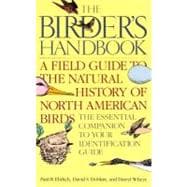
Note: Supplemental materials are not guaranteed with Rental or Used book purchases.
Purchase Benefits
What is included with this book?
Contents
Introduction
How to Use this Book
Right-hand Pages -- Essays
Left-hand Pages -- Species Treatments
Treatment Heading
Summary Line
Treatment Paragraph
Dealing with Uncertainty
Key to Summary Lines
Nest Location
Nest Type
Who Builds the Nest
Eggs
Mating system
Incubating Sex
Length of Incubation
Development at Hatching
Time from Hatching to Fledging
Who Tends the Young
Diet During Breeding
Foraging Techniques
Interpreting the Treatment Paragraphs
Breeding
Displays
Nest
Eggs
Diet
Conservation
Notes
Essays
References
Observing and Recording Bird Biology
Species Treatments (Even-numbered Pages)
Essays (Odd-numbered Pages)
Appendices
Hawaiian Bird Biology
Feral Birds
Pelagic Birds
DNA and Passerine Classification
North American Birds Omitted from the Species Treatments
Acknowledgments
Sources of Information Used in this Guide
Bibliography
Supplemental Bibliography
Guide to Essay Topics
Subject Index
Index to North American Birds
The New copy of this book will include any supplemental materials advertised. Please check the title of the book to determine if it should include any access cards, study guides, lab manuals, CDs, etc.
The Used, Rental and eBook copies of this book are not guaranteed to include any supplemental materials. Typically, only the book itself is included. This is true even if the title states it includes any access cards, study guides, lab manuals, CDs, etc.
How often have you come across a bird on a spring morning and stood motionless in an effort to determine what it was doing; to see whether it was near its nest, and if so, what kind of nest it built, or to see why it was holding its tail in an unusual position? Have you wondered what it ate, how many mates it had, how many eggs would occupy its nest, how long it would take them to hatch, or how helpless its hatchlings would be? While there are excellent field guides to help identify that bird, none provide comprehensive information on what it is doing, and why.
This field guide takes up where the others leave off -- that is once you have identified a bird. First, you can refer to an up-to-date condensed description of the biology of the species you have in view, and then you can read two or three brief essays which expand on that information and fit your bird into "the big picture" of avian ecology, behavior, and evolution. As you become familiar with this book's format, you will find that it also serves as a guide to what isnotknown about the biology of North American birds. We have indicated where, by making careful observations, you can contribute to the science of ornithology (see "Observing and Recording Bird Biology," p.XXVII).
The Birder's Handbook: A Field Guide to the Natural History of North American Birdsincludes all bird species (some 650 of them)known to nest regularlyon the continent, north of the Mexican border (with the exception of some exotic species that have escaped from captivity) and all the now-extinct birds known to have nested here since the arrival of Europeans.
Just as identification guides often present text on left-hand pages and illustrations on right-hand pages, this guide puts facing pages to different uses. Short synopses, called "species treatments," describing the biology of individual species are on left-hand pages of the main section of the book. The species are arranged in approximately the same order found in the second edition of the National Geographic Society'sField Guide to the Birds of North America(1987), the most recent standard identification guide at this writing and the one that follows most closely the sequence of species in the latest (1983, 1985, 1987) revision of and supplements to theChecklist of North American Birdsproduced by the American Ornithologists' Union (AOU). At the end of each species treatment you will find a list of essays (and the page number on which each starts) giving especially pertinent background material, followed by several references in the bibliography (p. 672) which provide entry to the detailed literature on the species.
The essays are presented on the right-hand pages facing these species treatments. They vary in length and cover important and interesting biological topics -- how flamingos feed, how different species of warblers divide hunting areas in conifer trees, how species are formed, how raptors can be conserved, why shorebirds sometimes stand on one foot, why birds rub themselves with ants, how migrating birds find their way, why the Passenger Pigeon became extinct, what determines how often hummingbirds feed, and what duck display mean, just to name a few of the numerous topics addressed. Also included is a series of biographical sketches of bird biologists who have made important contributions to understanding our birds, and some notes on the origins and meanings of North American bird names. To the degree possible, these essays are placed opposite species to which they are most relevant.
We have attempted in this small volume to condense the information that otherwise can be found only in a library of ornithological books and journals. The only other book that has attempted to present roughly equivalent coverage is now hopelessly out of date andweighs eight pounds.To achieve compactness we have had to use a highly condensed format for the presentation of data on the species treated. It therefore is important to read the next section, "How to Use This Book," so that the information will be readily accessible to you when birding.
Copyright © 1988 by Paul R. Ehrlich, David S. Dobkin, and Darryl Wheye
Excerpted from The Birder's Handbook: A Field Guide to the Natural History of North American Birds by Paul R. Ehrlich, David S. Dobkin, Darryl Wheye
All rights reserved by the original copyright owners. Excerpts are provided for display purposes only and may not be reproduced, reprinted or distributed without the written permission of the publisher.